The Main French Catapulted Observation Floatplane
The Loire 130 came from a request in 1933 from the French Navy for a reconnaissance seaplane that could also be used aboard French battleships and cruisers. Chosen in 1936 against five competitors, the Loire 130’s performance was considered good and production orders for 150 machines were placed. Production began in August 1936 at the SNCAO factory in Saint-Nazaire and since its entry into service in 1938 it replaced most of the on-board seaplanes already in service. It ended in 1941 with 124 examples including a prototype, 111 for the Navy and 12 for the French Air Force which used them in the colonies, particularly in French Indochina.
It is a three-seater catapultable reconnaissance seaplane. This high-wing monoplane has a metal structure. It can carry 7 people (crew included). In the years 1937-1938, the Loire 130 served aboard most of the battleships and cruisers of the French navy, as well as aboard the Commandant Teste (a squadron of 6 aircraft in 1939). Although appearing quite obsolete and having a very marginal execution, a few Loire 130s survived the Second World War and remained in post-war service, particularly in the French colonies, until 1949-1950.
1933 Competition and Prototypes
The most common French flying boat during the war was a small multi-purpose machine built in accordance with the 1933 specification for an “catapulted reconnaissance seaplane.” In accordance this, no less that six competitive prototype were proposed and tested, including the Loire 130, Breguet 610, Gourdou-Lesseurre GL.820, Levasseur PL 200, Lioré-et-Olivier N.43 and CAMS 120, all built bon time. This went on uuntil August 1, 1936, when the Loire model was chosen and a first batch of 45 were ordered.
Prototype and production: 130M and 130C
The prototype made its maiden flight on November 19, 1934 pushed by an Hispano-Suiza 12X engine rated for 720 hp. The first order included 40 Loire 130M (“Metropolitan (france)”) and five Loire 130C (“Colonial”). The latter had an enlarged radiator tio better cope with the hear, and reinforced structure to carry bombs and an OPL 38 sight plus specific tropical adaptations (filter, better internal cooling etc). 130Ms were thus faster (+19 km/h) had two 7.5 mm Darne machine guns, two 75 kg G2 bombs and received the Hispano-Suiza 12X ISRL engines with the same output as the prototype. In 1936, a second order was placed for ten boats. This was followed by a contract for 20 more on March 19, 1937, and 19 by October 21, 1938. The latter order included only the Loire 130C modification, of which 12 were intended for air force units in the colonies.
The exact number of aircraft produced is unknown, but it is unlikely that all of the 150 flying boats built were actually built by the beginning of 1940. It is known that the plant in Saint-Nazaire completed 30 Loire 130 aircraft for the Vichy government fleet, before switching to the production of German float Ag 196.
Design of the Loire 130
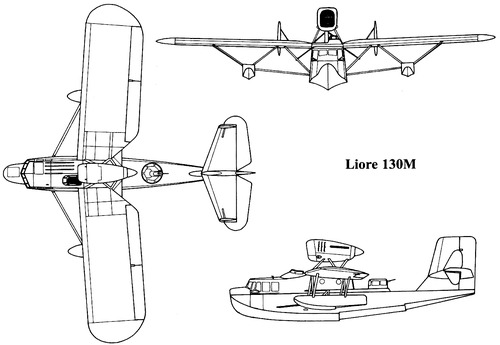
It had had an all-metal structure with wing and tail covered with fabric. The crew was usually required to consist of three, pilot, observer/radio operator and MG gunner/mechanic, but it could carry four passengers. During the tests, additional fins located at the ends of the stabilizer were increased in area due to noted stability problems by test pilots. The design of the radiator was also changed.
Production was marred by reorganizations, following the Socialist government elections, as the Saint-Nazaire Factory were absorbed by a new consortium called the Société Nationale des Constructions Aéronautiques de l’Ouest (S.N.C.A.O.). Designation did not changed, but delays accumulated, whereas more were ordered, 10 in 1936, 20 in March 1937, 19 in octobrer 1938.
In October 1939, the Navy decided to ask for a wooden wing in order to save metal. The wooden wing was manufactured at Saint-Nazaire and installed on the 18th production model. She was undergoing flight tests, a first on November 20, 1939. But issues of rigidity were immediately noted and the wooden wing was not ported into production.
General design
The The Ateliers et Chantiers de la Loire (simplified as “Loire”) created a central hull seaplane of metal construction. The fully enclosed cockpit has two side-by-side seats. A third station, open but protected by a windshield was located behind the cockpit on the roof. There was enough room insiode the hull to even carry four passengers. The wings were braced by a tubular structure, in parasol configuration to maximize vision, with some dihedral and rounded ends. To limit space on board a hangar, they could be folded and tips removed. The two underwing floats were mounted approximately at mid-span. The tailplane is cross-shaped, with a very large fin for stability and horizontal tailplanes fitted with compensators.
Powerplant
The Hispano-Suiza 12Xirs engine delivered initially 720 hp (540 kW) and was a liquid-cooled V12 installed over the wings, supported by struts, in a pusher configuration. It drove a three-blade propulsive propeller.
Armament
The armament consisted of two 7.5mm Darne machine guns for self-defense, one aft, on flexible mount and one forward, fixed, plus two 75kg depth charges or two G-2 bombs underwings.
⚙ Loire 130 specifications |
|
| Empty Weight | 2,050 kg (4,519 lb) |
| Gross Weight | 3,260 kg (7,187 lb), Max TO 3,500 kg (7,716 lb) |
| Lenght | 11.300 m (37 ft 0+7⁄8 in) |
| Wingspan | 15.999 m (52 ft 5+7⁄8 in) |
| Height | 3.848 m (12 ft 7+1⁄2 in) |
| Wing Area | 38.17 m2 (410.9 sq ft) |
| Engine 130M | Hispano-Suiza 12Xirs liquid-cooled V12 engine, 540 kW (720 hp) |
| Engine 130C | Hispano-Suiza 12Ycrs liquid-cooled V12 engine, 540 kW (720 hp) |
| Top Speed | 220 km/h (137 mph, 119 kn) at 2,100 m (6,890 ft) |
| Cruise Speed | 164 km/h (102 mph, 89 kn) at 1,500 m (4,920 ft) |
| Range | Unknown, 7.5 hr at 150 km/h (93 mph) and 500 m (1,640 ft) |
| Climb rate | 12 min to 3,000 m (9,840 ft) |
| Ceiling | 6,000 m (19,685 ft) |
| Armament | 2 x 7.5 mm Darne machine guns, 2 x 75 kg (165 lb) bombs |
| Crew | 3+4 passengers |
Operational History

Model of Flotille 1HS aboard an unidentified La Galissonière class cruiser. The catapult was located on the deported aft turret for a true 360° arc for launching, with the hangar close to the aft funnel.
As said above, two models were delivered to the French Navy, a majority of 130M for France itself, both the Mediterranean and Atlantic fleet and the remainder of 130C for Indochina and Equatorial or south Africa (Dakar and Magadascar)
At the beginning of the Second World War, Loire 130Ms in the Mediterranean fleet served on the commandant teste as well as the battleships Dunkerque and Strasbourg later based at Mers el Kebir, and the training cruiser Jeanne d’Arc (later interned in French West Indies) and cruisers of the 1st, 2nd, 3rd and 4th divisions (Suffren class, Duquesne class, Bertin, Algérie, La Galissonière class), plus shore-based squadrons 1S1 and 3S6. The French Air Force operated also Squadron 1/CBS with existing Loire 130C in Indochina. From December 1939 to February 1940, three new squadrons were formed – 8S2 in the West Indies, 8S3 in Dakar and 8S4 in Tripoli, Libya. On 23 May, 1S1 Squadron was re-equipped with the torpedo-carrying Latécoères 298s as Cherbourg and Boulogne, Atlantic Fleet.
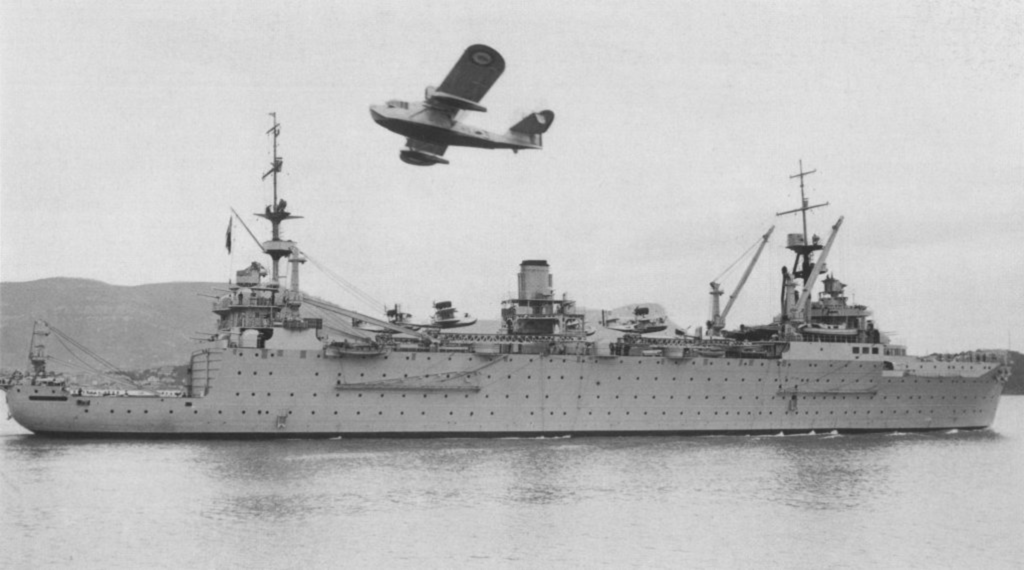
Aboard Cdt Teste as part of the Mediterranean Fleet in 1939, it’s major operator
On August 1, 1940, the French Navy had 62 Loire 130 in service, six in Flotille 17S, three in Flotille 18S, six in Flotille 19S, one in Saigon, 21 on board various ships (all Flotille 1HS) and those of Commandant Teste were unloaded ashore. In June, 1HS Squadron was disbanded and assets divided in Dakar between Flotille 4E and battleship Richelieu leaving Saint-Nazaire uncomplete to Dakar to avoid capture. One Loire 130 flew from Karouba to Malta in the autumn of 1940. In February 1941, three flew against orders from Martinique to the British West Indies, rallying the Free French, and another from Tripoli to Palestine, also joining the Free French. The rest were repainted under Vichy colors (tail and engine in yellow-red bands).
All production had stopped in June 1940 and soon St Nazaire Factory were seized by the Germans. After some tractations with the Vichy Government, they accepted that production restarted for the needs of the French Navy, and 30 more were produced until the fall of 1941 before production was turned to German needs. A single Loire 130M was tested and retained by the Luftwaffe for training.
In November 1942 Operation Torch saw many ships in North Africa sunk or damaged, and those in Toulon were scuttled as the German invaded the Free zone. Soon after all remaining catapults of Free French ships were landed, to accommodate additional AA guns and all Loire 130s were transferred to shore operations, now on Free French side (some were captured by the Germans as well). They were used for coastal patrol, communications and training in 1942-43. By November 1943, 15 Loire 130s including the prototype were found at the Bel Air naval air base near Dakar. Six were also part of the reconnaissance arm of the 7th Flotilla alongside British FAA Sunderlands, looking for U-Boats. Meanwhile the 130C operated by the Air Force were partly kept in Indochina.
Due to spare parts shortages, they gradually fall into no-flying condition, but still many survived the war. The new French government decided in September 1945 not to repair or overhaul existing Loire 130 given their age and all flyable ones were gathered at the seaplane pilot school (Flotille 53S), in operation until the fall of 1947. One flew in Indochina, as part of Flotille 8S in December 1949, taking part in patrols during the Indochina War.
Read More
Links
aviationsmilitaires.net loire-130
airwar.ru/
en.wikipedia.org
armedconflicts.com/
fr.wikipedia.org/
aviastar.org
Model Kits
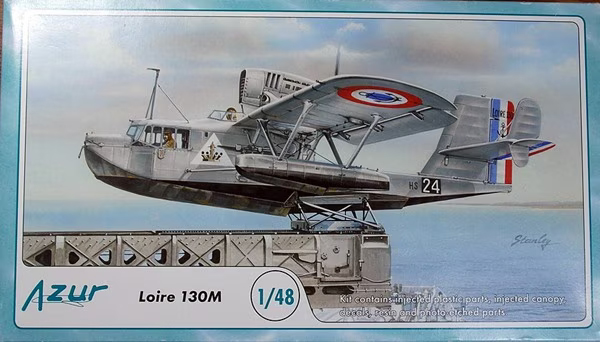
So far it was covered by Azur at 1:72.
Video
Gallery
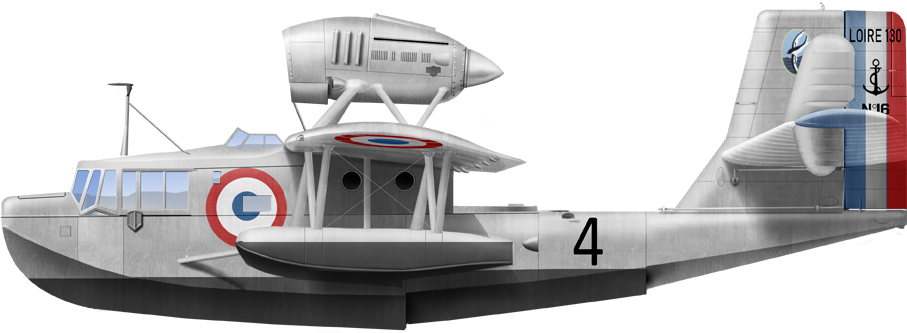
Illustrations by the author: Loire 130, Escadrille HS1 on Commandant Teste, Arzew, North Africa, May 1940
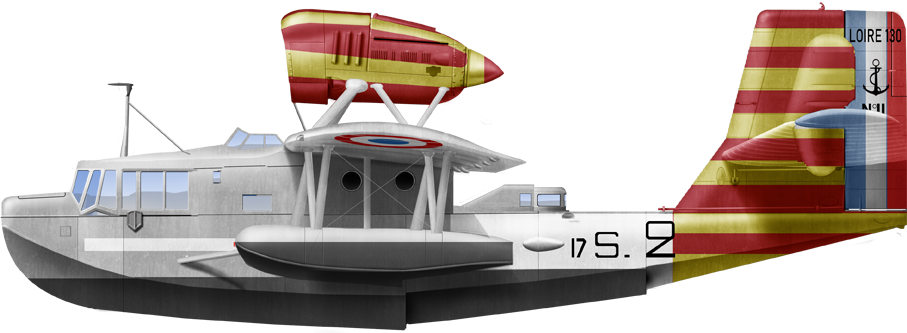
Loire 130C with Vichy Forces, Flotille S2










 Latest Facebook Entry -
Latest Facebook Entry -  X(Tweeter) Naval Encyclopedia's deck archive
X(Tweeter) Naval Encyclopedia's deck archive Instagram (@navalencyc)
Instagram (@navalencyc)





 French Navy
French Navy Royal Navy
Royal Navy Russian Navy
Russian Navy Armada Espanola
Armada Espanola Austrian Navy
Austrian Navy K.u.K. Kriegsmarine
K.u.K. Kriegsmarine Dansk Marine
Dansk Marine Nautiko Hellenon
Nautiko Hellenon Koninklije Marine 1870
Koninklije Marine 1870 Marinha do Brasil
Marinha do Brasil Osmanlı Donanması
Osmanlı Donanması Marina Do Peru
Marina Do Peru Marinha do Portugal
Marinha do Portugal Regia Marina 1870
Regia Marina 1870 Nihhon Kaigun 1870
Nihhon Kaigun 1870 Preußische Marine 1870
Preußische Marine 1870 Russkiy Flot 1870
Russkiy Flot 1870 Svenska marinen
Svenska marinen Søværnet
Søværnet Union Navy
Union Navy Confederate Navy
Confederate Navy Armada de Argentina
Armada de Argentina Imperial Chinese Navy
Imperial Chinese Navy Marinha do Portugal
Marinha do Portugal Mexico
Mexico Kaiserliche Marine
Kaiserliche Marine 1898 US Navy
1898 US Navy Sovietskiy Flot
Sovietskiy Flot Royal Canadian Navy
Royal Canadian Navy Royal Australian Navy
Royal Australian Navy RNZN Fleet
RNZN Fleet Chinese Navy 1937
Chinese Navy 1937 Kriegsmarine
Kriegsmarine Chilean Navy
Chilean Navy Danish Navy
Danish Navy Finnish Navy
Finnish Navy Hellenic Navy
Hellenic Navy Polish Navy
Polish Navy Romanian Navy
Romanian Navy Turkish Navy
Turkish Navy Royal Yugoslav Navy
Royal Yugoslav Navy Royal Thai Navy
Royal Thai Navy Minor Navies
Minor Navies Albania
Albania Austria
Austria Belgium
Belgium Columbia
Columbia Costa Rica
Costa Rica Cuba
Cuba Czechoslovakia
Czechoslovakia Dominican Republic
Dominican Republic Haiti
Haiti Hungary
Hungary Honduras
Honduras Estonia
Estonia Iceland
Iceland Eire
Eire Equador
Equador Iran
Iran Iraq
Iraq Latvia
Latvia Liberia
Liberia Lithuania
Lithuania Mandchukuo
Mandchukuo Morocco
Morocco Nicaragua
Nicaragua Persia
Persia San Salvador
San Salvador Sarawak
Sarawak Uruguay
Uruguay Venezuela
Venezuela Zanzibar
Zanzibar Warsaw Pact Navies
Warsaw Pact Navies Bulgaria
Bulgaria Hungary
Hungary

 Bundesmarine
Bundesmarine Dutch Navy
Dutch Navy Hellenic Navy
Hellenic Navy Marina Militare
Marina Militare Yugoslav Navy
Yugoslav Navy Chinese Navy
Chinese Navy Indian Navy
Indian Navy Indonesian Navy
Indonesian Navy JMSDF
JMSDF North Korean Navy
North Korean Navy Pakistani Navy
Pakistani Navy Philippines Navy
Philippines Navy ROKN
ROKN Rep. of Singapore Navy
Rep. of Singapore Navy Taiwanese Navy
Taiwanese Navy IDF Navy
IDF Navy Saudi Navy
Saudi Navy Royal New Zealand Navy
Royal New Zealand Navy Egyptian Navy
Egyptian Navy South African Navy
South African Navy






























 Ukrainian Navy
Ukrainian Navy dbodesign
dbodesign